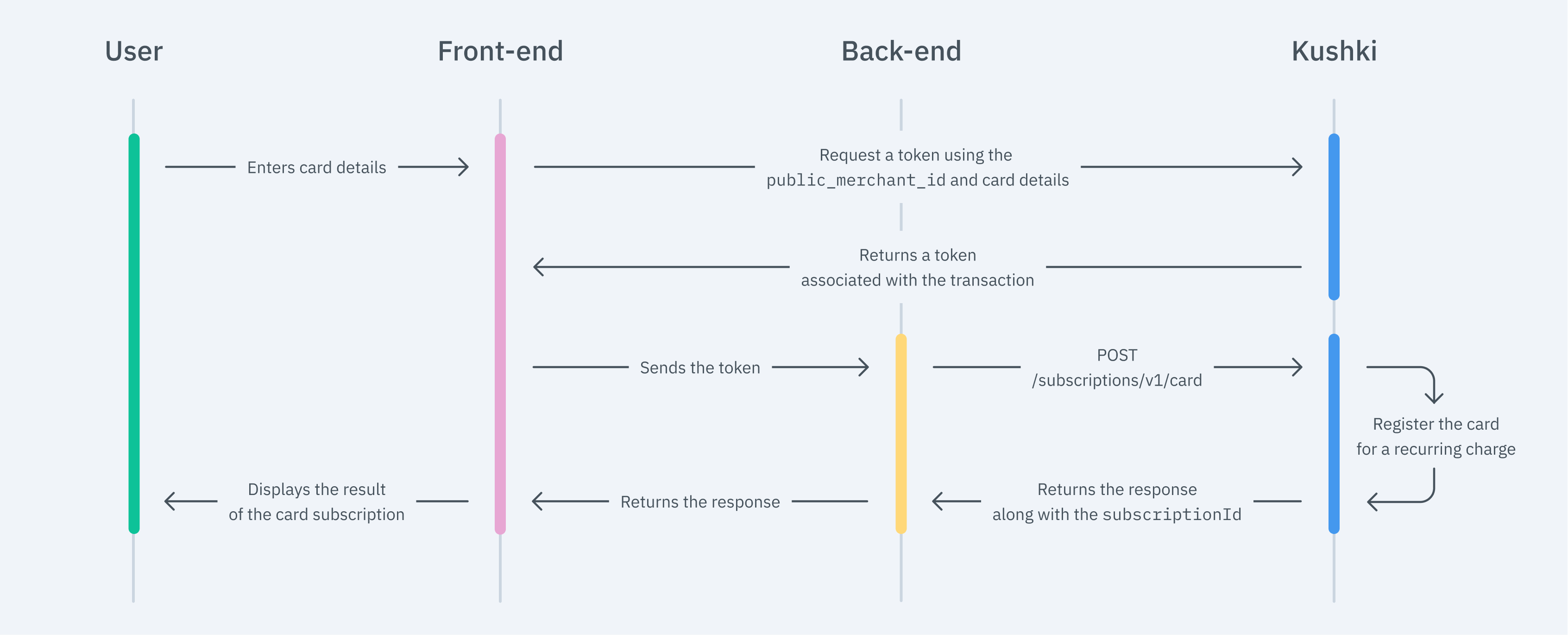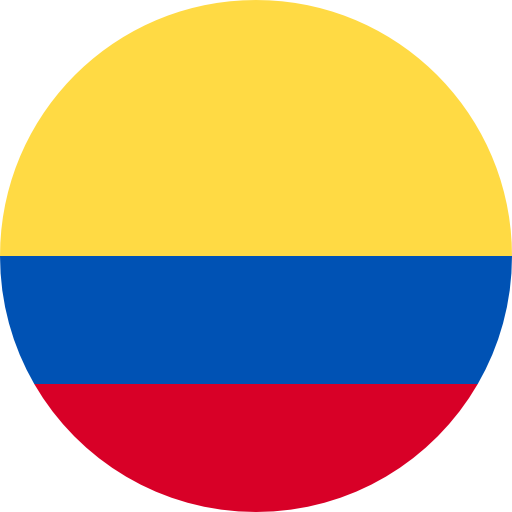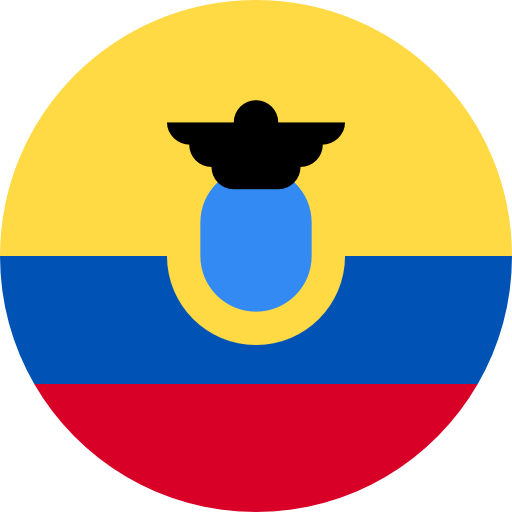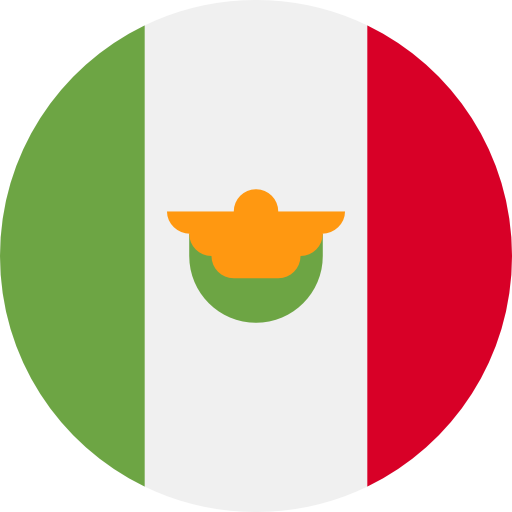Create a recurring charge
Register your customers' credit or debit card data to charge them with the frequency that you define for payments
This functionality is available for the following models:
☑ Acquirer
☑ Aggregator
Receiving recurring payments with debit and credit cards on your website means capturing the card’s information, generating a token, and creating a subscription in Kushki. This allows charges to be automatically made with the periodicity you prefer.
This is an example of what you can integrate:
The payment flow that you will integrate is as shown below:

1. Set up your Front-end
The front-end is responsible for collecting the user’s card details securely, generating a token for such information through Kushki’s servers, and sending that information to the back end to start the payment process.
You have three options to integrate: Kajita, Kushki.js and Kushki.js Hosted Fields.
Kajita
Kushki has payment forms ready to collect card information securely. You can use any of our versions:
- Cajita: the first version of the predefined payment form. Not customizable.
- Kajita: the second version. It allows you to customize your payment forms from your Administration Console and even have several versions of Kajita, for example, one for each payment method.
Create and customize your Kajita
With Kushki you can create your Kajitas from the Administration Console. Click here to learn how to do this.
Set up Kajita
Include the kushki-checkout.js script in your payment page by adding it to the <head> of your HTML file. Always load kushki-checkout directly from cdn.kushkipagos.com. Do not include the script in a bundle or package or host a copy of it.
<head><title>Checkout</title><script src="https://cdn.kushkipagos.com/kushki-checkout.js"> </script></head>
Add Kajita to your Website
Kajita needs a space within your page. Enter the following code in your website’s <body>, where you want the payment form to be displayed.
For Kajita (v.2):
<form id="my-form" action="/confirm" method="post"><input type="hidden" name="cart_id" value="123"></form>
For Cajita (v.1):
<form id="payment-form" action="/confirm" method="post"><input type="hidden" name="cart_id" value="123"></form>
Remember to configure the action of the action form according to the corresponding endpoint in your back-end. This will allow you to obtain the token.
For the Kajita (v.2) you can obtain such script from your Administration Console as explained here.
Then, add the following script tag.
<script type="text/javascript">var kushki = new KushkiCheckout({kformId: "HmJXukKb5",form: "my-form",publicMerchantId: "${publicCfredentialId}",// Reemplaza esto por tu credencial públicaamount: {subtotalIva: 0,iva: 0,subtotalIva0: 1000,}});</script>
For v.1 (Cajita), add the following script, making sure the form has loaded:
<script type="text/javascript">var kushki = new KushkiCheckout({form: "payment-form",merchant_id: "88ba4bff110548d09acde8d326c71253", // Reemplaza esto por tu Public Keyamount: "14.99",currency: "USD",payment_methods:["credit-card"],is_subscription: true,inTestEnvironment: true // Configurado en modo prueba});</script>
This will create a predesigned form on your website to accept payments.
Kushki.js
Use Kushki.js if you need more control over the “look & feel” or appearance of your payment form.
Set up Kushki.js
Option 1 - CDN
Use the following script tag at the end of the <body> of your payment page.
<script src="https://cdn.kushkipagos.com/kushki.min.js"></script>
Option 2 - npm
Install the package from npm.
npm install --save @kushki/js
Then import it in your code using the following code.
import { Kushki } from “@kushki/js”;
Set up Kushki Object.
Add the following code to your application
var kushki = new Kushki({merchantId: '88ba4bff110548d09acde8d326c71253', // Replace this with your Public KeyinTestEnvironment: true, // Configured in test mode});
Collect User Information and Send it to your Back End
First, embed the form in your payment page adding the required fields. You can design it in the way that best suits you.
For example:
<form id="payment-form"><input placeholder="Card Number" type="text" name="number"><input placeholder="Full Name" type="text" name="name"><input placeholder="MM" type="text" name="expiry_month"><input placeholder="YY" type="text" name="expiry_year"><input placeholder="CVC" type="text" name="cvc"><button id="submit">Pay $14.99</button></form>
And, for the moment the user submits the form, add the token request and take it to your back end.
kushki.requestSubscriptionToken({currency: "USD",card: {name: form.name,number: form.number,cvc: form.cvv,expiryMonth: form.expiry_month,expiryYear: form.expiry_year,},}, (response) => {if(!response.code){console.log(response.token);// Submit your code to your back-end} else {console.error('Error: ',response.error, 'Code: ', response.code, 'Message: ',response.message);}});
Kushki.js Hosted Fields
With Hosted Fields, included in Kushki.js, you can securely collect customer payment information through fields stored on Kushki infrastructure. Returns a token which allows the payment flow to continue from the back-end.
Import Kushki.js Hosted Fields into your app
Option 1 - CDN
Import the Kushki.js Hosted Fields library into your application via a <script> tag inside the <body> tag. Once imported, you will be able to access the resources described below to create a payment flow with Kushki.
It is necessary to import the libraries kushki.min.js (which brings the necessary code to store your merchant’s credentials) and card.min.js (the module that brings the necessary functionalities for the flow with card payments).
<script src="https://cdn.kushkipagos.com/js/latest/kushki.min.js"></script><script src="https://cdn.kushkipagos.com/js/latest/card.min.js"></script>
Option 2 - NPM
Install the Kushki.js Hosted Fields library as an npm package inside your application with the following code:
npm install --save @kushki/js-sdk
Option 3 - YARN
Install the Kushki.js Hosted Fields library as a yarn package inside your application with the following code:
yarn install @kushki/js-sdk
Create an instance of KushkiOptions
To use the Kushki.js Hosted Fields library, it is necessary to create an instance of KushkiOptions which allows you to set the public key of the work environment (test or production) through the init() method.
Add the following code to your application:
import { IKushki, init, KushkiError } from "@kushki/js-sdk";const kushkiOptions : KushkiOptions = {publicCredentialId: '<public-credential-id>', // This corresponds to the public credential of the merchantinTest: true};const buildKushkiInstance = async () => {try {const kushkiInstance : Ikushki = await init(kushkiOptions);} catch (e: KushkiError) {console.error(e.message);}}
Check the reference for more information about the KushkiOptions instance.
Initialize the form on the front-end
Follow the steps below to render the hosted fields. This way, your clients will be able to enter the necessary data to carry out transactions.
Step 1. Define containers for hosted fields.
Before calling the initCardToken() method, it is required to place the necessary elements to be able to render each hosted field.
<!DOCTYPE html><html lang="en"><body>...<form><div id="cardholderName_id"></div><div id="cardNumber_id"></div><div id="cvv_id"></div><div id="expirationDate_id"></div><div id="deferred_id"></div> //optional</form>...</body></html>
Step 2. Create an instance of CardOptions
Create an instance of CardOptions with the transaction information, such as the amount, currency, among other parameters.
import { IKushki, init, KushkiError } from "@kushki/js-sdk";import {CardOptions,ICard,initCardToken} from "@kushki/js-sdk/Card";const options : CardOptions = {amount: {iva: 1,subtotalIva: 10,subtotalIva0: 10},currency: "USD",fields: {cardholderName: {selector: "cardholderName_id"},cardNumber: {selector: "cardNumber_id"},cvv: {selector: "cvv_id"},expirationDate: {selector: "expirationDate_id"}}}
Step 3. Render hosted fields with the initCardToken() method
After creating an instance of CardOptions, you need to call the initCardToken() function to initialize an instance of ICard.
const buildCardInstance = async () => {try {// kushkiInstance must be previously initializedconst cardInstance: ICard = await initCardToken(kushkiInstance, options)} catch (e: KushkiError) {console.error(e.message);}}
Check the reference for more information on form initialization.
Request a token to continue the payment flow
Request a card payment token that you can later use to charge a customer with the endpoint to create a recurring charge.
To obtain a card payment token, it is necessary to call the requestToken() method on the previously initialized card instance. This method performs 3DS and Sift Science validations automatically. Also, validate that all the fields are correct; otherwise it will throw an exception.
// If deferred data is generated, you can use this data in the charge of the paymenttry {const tokenResponse: TokenResponse = await cardInstance.requestToken();// Code to send the obtained token to your back-end// On Success, if deferred data exist can get deferred options// For Ecuador, Mexico ex. {token: "a2b74b7e3cf24e368a20380f16844d16", deferred: {creditType: "03", graceMonths: 2, months: 12}}// For Chile, Colombia, Peru ex. {token: "a2b74b7e3cf24e368a20380f16844d16", deferred: {months: 12}}if(tokenResponse.deferred)console.log("This is a deferred options", tokenResponse.deferred)} catch (error: any) {// On Error, catch responseconsole.error("Catch error on request card Token", error.code, error.message);}
Once the token is obtained, send it to your back-end to continue the payment flow.
See the reference for more information about the token request.
2. Set up your Back End
The back-end’s responsibility is to receive the token obtained from your front-end and create the subscription with Kushki.
When the user submits the form, your front-end sends a token to an endpoint you’ve specified. With this token, you will need to make a call to our API endpoint to create the subscription.
- Javascript
- Python
- PHP
var request = require("request");var options = {method: 'POST',headers: ['Private-Merchant-Id': '0c0b08cd92fc491fb37365170164f7e9', // Replace this with your Private Key'Content-Type': 'application/json']url: 'https://api-uat.kushkipagos.com/subscriptions/v1/card', // Test environmentheaders: {'content-type': 'application/json'},body: {token: 'V0OzRB100000xhxQB8035251pHLBQsq5', // Replace this with the token you receivedamount: {subtotalIva: 0, subtotalIva0: 14.99, ice: 0, iva: 0, currency: 'USD'},planName: 'Premium',periodicity: 'monthly',contactDetails: {firstName": 'Juan', lastName: 'Flores', email: 'pruebas@kushki.com', phoneNumber: '+593984775632'},startDate: '2021-09-25', // Date of the first chargemetadata: {contractID: '157AB'}},json: true};request(options, function (error, response, body) {if (error) throw new Error(error);console.log(body);});
import requestsurl = "https://api-uat.kushkipagos.com/subscriptions/v1/card"payload = "{\"token\":\"V0OzRB100000xhxQB8035251pHLBQsq5\",\"amount\":{\"subtotalIva\":0,\"subtotalIva0\":14.99,\"ice\":0,\"iva\":0,\"currency\":\"USD\"},\"planName\":\"Premium\",\"periodicity\":\"monthly\",\"contactDetails\":{\"firstName\":\"Juan\",\"lastName\":\"Flores\",\"email\":\"pruebas@kushki.com\",\"phoneNumber\":\"0984775632\"},\"startDate\":\"2021-09-25\",\"metadata\":{\"contractID\":\"157AB\"}}"headers = {'Content-Type': 'application/json','Private-Merchant-Id': '0c0b08cd92fc491fb37365170164f7e9' // Replace this with your Private Key}response = requests.request("POST", url, data=payload, headers=headers)print(response.text)
$client = new http\Client;$request = new http\Client\Request;$body = new http\Message\Body;$body->append('{"token":"V0OzRB100000xhxQB8035251pHLBQsq5","amount":{"subtotalIva":0,"subtotalIva0":14.99,"ice":0,"iva":0,"currency":"USD"},"planName": "Premium","periodicity": "monthly","contactDetails": {"firstName":"Juan","lastName":"Flores","email":"pruebas@kushki.com","phoneNumber":"0984775632"},"startDate":"2021-09-25","metadata":{"contractID":"157AB"}}');$request->setRequestUrl('https://api-uat.kushkipagos.com/subscriptions/v1/card');$request->setRequestMethod('POST');$request->setBody($body);$request->setHeaders(array('Private-Merchant-Id' => '0c0b08cd92fc491fb37365170164f7e9', // Replace this with your Private Key'Content-Type' => 'application/json'));$client->enqueue($request)->send();$response = $client->getResponse();echo $response->getBody();
According to the response you obtained, redirect the user to a success or fail screen to inform the customer if the subscription was created correctly or if an error occurred.
3. Test your Integration
You can use some test cards in test mode to ensure that your integration is ready. Use them adding any CVV and a future expiration date.
- Approved transaction:
5451951574925480 - Transaction declined during token request (front end):
4574441215190335.
4. Prepare your Certification
Read the following guidelines for technical certification approval (required to obtain productive account credentials):
- Tax calculations must be correct.
- Sensitive card data are not stored in your database (full card number, CVV, etc.).
- Messages displayed on the screen are in line with Kushki’s responses.
- All Kushki responses must be saved (required in case you need support).
- The first payment date (startDate) must be a future date.
- The subscription is also canceled in Kushki when your customer decides to cancel his/her recurring charges.
- Kushki’s logo must be visible for the customer. You can find our logo in several formats here.
- Make sure all the required data as specified in the API Reference are sent.
If you are using Kushki.js, also check the following:
- The cardholder’s name must be required.
- The card number field must be required.
- The card number field must only accept numbers.
- The credit card field must allow a maximum of 16 digits (there may be less).
- The CVV field must be required.
- The CVV field must accept only numbers.
- The CVV field must allow no more than 4 digits and no less than 3 digits.
- The expiration date must be required.
- The payment button must be disabled after the first click.
- Kushki’s logo must be visible for the customer. You can find our logo in several formats here.
Manage your customers' subscriptions
Edit data or cancel automatic charges.
Accept Webhooks
Manage correctly post-payment events.
 Chile
Chile Colombia
Colombia Ecuador
Ecuador Mexico
Mexico